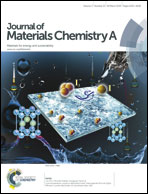LUMO's modulation by electron withdrawing unit modification in amorphous TAT dumbbell-shaped molecules†
Abstract
The synthesis and characterization of a series of dumbbell-shaped molecules constructed from paraffin-free central dyes linked to two triazatruxene (TAT) units are described. The photovoltaic properties of these new glassy electron-donating molecules in a bulk heterojunction with fullerene derivatives have been studied. For this series of molecules, the local-range molecular packing in the amorphous solid state is mainly influenced by the TAT units bearing bulky side-chains, while the optical properties and energy levels are tuned by the choice of the central core. Therefore, TAT acts as a structuration platform in thin films for pure or blended active layers and independently, the optoelectronic properties are driven by the choice of the central dye. Photovoltaic cells based on these materials exhibited power conversion efficiencies of up to 3.5%, among the top values reported so far for soluble amorphous small molecule based organic photovoltaic devices. These TAT-based derivatives are a promising platform to reach high solar cell efficiencies as well as to understand in detail the impact of the chemical structure on the optoelectronic properties.


 Please wait while we load your content...
Please wait while we load your content...